|
Forklift
Version original
Anglais:
howworkliftworks_an Version française
commentfonctionnelecontrepoids_fr
Information: Lien en Web
Anglais
ICI
Operating Information
How a Forklift Works
La documentation française est sur le site en plusieurs
sections. ainsi que les liens attenants.
Check-lists en anglais et en français
Versions :
trucks_stability_an
stabilité des chariots
élevateur.php

Please be sure to read the
Safety information that accompanies this product.
Additional forklift safety information also is available
at the following links:
Types of
Forklifts
Select a
Safe Forklift
Explosion/Combustion
Hazards
Daily
Checklist (Note: Daily Checklist is in pdf
format) is a sample operator’s “Daily Forklift
Safety Checklist” that can be attached to the forklift
as a reminder to the operator to do this
check.
Voir un
échantillon de
Checklist stickers
La documentation française est sur le site en plusieurs
sections. ainsi que les liens attenants.
Check-lists en anglais et en français.
Driving a forklift is different
than driving a car
In a car or truck the front
wheels steer the vehicle. A forklift has the steering
wheels in the rear. The rear end of the forklift swings
in a circle around the front wheels that support most of
the load. The operator must check that there is room for
the rear end to swing when making turns.
This
clearance can be maintained in your workplace by
permanently marking aisles with painted lines or
arranging storage racks in a way that creates obvious
aisles for travel.
However, these marked aisles
will only be effective if you keep them clear of stored
materials, which can gradually encroach as space is
needed.
A forklift is not as responsive as a car
when turning the steering wheel. Rear steering makes it
difficult to stop a forklift quickly or swerve and still
maintain control. It is important, then not to drive a
forklift fast or round corners quickly.
 Driving with the load downhill can result
in loss of the load and control of the
forklift. Driving with the load downhill can result
in loss of the load and control of the
forklift.
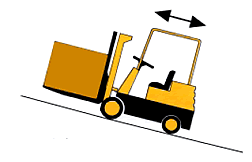 |
| Keep the
load uphill to maintain control of the
forklift. |
If
you drive a forklift on an incline, you must keep the
load on the uphill side. Otherwise, you may have no
weight on the wheels that steer and can lose control!
The load could also fall off or cause the forklift to
tip.
Often a large forklift load obstructs the
driver’s view in one direction. It may be necessary to
travel long distances with the load to the rear (in
reverse for most forklifts). Use extra caution when
traveling in reverse.
Forklift safety
features
A backrest extension on the forks
prevents part of the load from falling rearward toward
the operator. This is required when loads are lifted
high and the type of load would allow all or part of it
to fall to the rear under conditions such as
acceleration, sudden stops or driving on an uneven
surface.
An overhead guard prevents an object on
the forks or on a high rack from falling onto the
operator while picking or placing a load at elevation.
The guard is not designed to withstand the impact from a
full load. It can be effective in deflecting small
packages. It is required on all forklifts that can lift
a load above the operator unless conditions such as
clearances would not allow the forklift to be
used.
Operator restraints will hold you in the
seat if you strike an object or if the forklift
overturns. Since 1992, forklift manufacturers have been
required to equip new forklifts with operator restraints
such as seat belts. Many forklift manufacturers offer
restraint systems that can be retrofitted on older
forklifts.
If your forklift begins to overturn,
you are safest when you stay in the seat, hold on
firmly, and lean in the opposite direction of the fall
rather than trying to jump. Many fatal accidents
happened when the operator tried to jump. As the
forklift begins to tip, it will move slowly - tricking
the operator into believing there is time to jump. Once
the center of gravity is past the wheel line, the
forklift will rapidly fall. The forklift’s overhead
guard will quickly pin or crush an operator who
jumps.
 Failure to wear a seat belt can result in the
operator being thrown outside the protective cage in the
event of overturn.
Failure to wear a seat belt can result in the
operator being thrown outside the protective cage in the
event of overturn.
If your forklift has a
restraint such as a seat belt or a lap bar, you must use
it.
How forklifts safely carry and lift
heavy loads
A forklift works on the principle
of a cantilever. A load on a beam (the forks) supported
by a fulcrum (the front wheels) is counterbalanced by a
weight on the other end of the beam (the forklift body
and counterweight built into it).
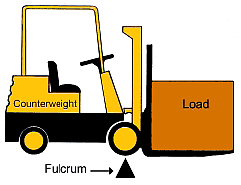 Whether a forklift will
safely carry a load or will tip forward can be
determined by comparing the "moment" of
each. Whether a forklift will
safely carry a load or will tip forward can be
determined by comparing the "moment" of
each.
Moment equals the distance from the fulcrum
to the center of gravity (the point where all the weight
is concentrated) times the weight.
Example: an
evenly distributed 36" wide load on the forks has a
center of gravity that is 18" from the face of the
forks. (Note: The fulcrum point is actually at the
center of the wheel. Forklift load charts, however, are
adjusted to allow measuring from the face of the
forks.) If the load weighs 4000 pounds then the
load moment will be (18" x 4000 lb.) = 72,000
inch-pounds.
If the "moment" of the forklift is
greater than or equal to the 72,000 inch pounds of the
load then the forklift will safely carry the load.
Forklifts have a capacity plate to tell the user what
loads are safe to lift. If the plate says the capacity
is 30,000 pounds or less then that capacity is rated for
a load with a center of gravity 24” from the face of the
forks. If the forklift capacity is greater than 30,000
pounds then the label will rate the load at a 36" or 48"
center of gravity since larger forklifts usually lift
physically larger loads.
For example, a forklift
rated at 5000 pounds would safely lift a load with a
moment of up to (24" X 5000 lb.) = 120,000 inch-pounds.
In this case the load above would be safe to
lift.
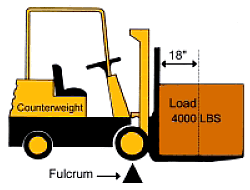 |
Forklift Moment = (24" x 5000
lbs.) = 120,000 inch-pounds.
The load is
safe to lift because load moment is less than
forklift
moment. |
However
if the 4000 pound load was 66" wide, the load moment
would be (33" X 4000 lb.) = 132,000 inch-pounds which
would be greater than the moment of the forklift. The
forklift would tip forward.
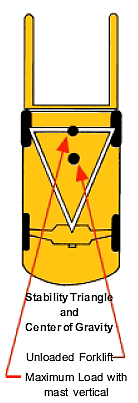 As the load is raised, it
becomes possible for the forklift to fall to the side as
well as tip forward. The operator must consider the
center of gravity of the forklift and load together.
This combined center of gravity moves as the load is
moved and as the forklift travels over surfaces that are
rough or inclined. As the load is raised, it
becomes possible for the forklift to fall to the side as
well as tip forward. The operator must consider the
center of gravity of the forklift and load together.
This combined center of gravity moves as the load is
moved and as the forklift travels over surfaces that are
rough or inclined.
Forklifts have a "stability
triangle". The sides of the triangle as shown in the
illustration are formed by the center of each front
wheel and the center of the rear wheel or at the center
of the axle if there are two rear wheels.
A
vertical line extending from the center of gravity of
the vehicle-load combination must be inside of the
stability triangle to prevent the forklift from tipping
forward, falling sideways or dropping its load.
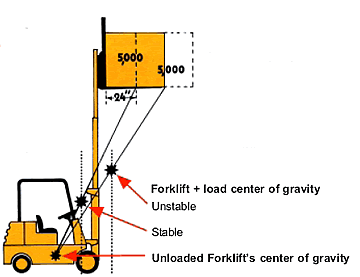
The center of gravity of the
forklift-load combination can move outside the stability
triangle if:
- The load is picked up on the tip of the forks,
- The load is tilted forward,
- The load is tilted too far back when raised,
- The load is wide, or
- Forklift movement causes the center of gravity to
shift.
These actions will have the
following effects:
|
Action |
Center of gravity
moves: |
| Tilting the load
forward |
Toward the front
axle |
| Raising the load while
tilted forward |
| Driving on an incline
with the load downhill |
| Stopping forward
travel or accelerating backward |
| Tilting the load
back |
Toward the rear
axle |
| Raising the the load
while tilted back |
| Driving on an incline
with the load uphill |
| Accelerating forward
or stopping backward travel |
| Driving across an
inclined surface |
Toward the downhill
side of the triangle |
| Driving across a rough
or uneven surface |
Toward the rut or low
side of the triangle |
| Turning |
Toward the side now
facing the original direction of
travel |
 This list represents operator procedures
that reduce the risk of overturn, collision or loss of
the load. This list represents operator procedures
that reduce the risk of overturn, collision or loss of
the load.
To prevent your forklift from
tipping over, falling sideways or dropping its load:
- Make sure the load is stable and safely arranged
on the forks.
- Do not tilt the forks forward except when picking
up or depositing a load.
- Tilt the load backward only enough to stabilize
the load.
- Keep the load low just above the pavement with
forks tilted back when traveling.
- Cross railroad tracks diagonally when
possible.
- Enter elevators squarely.
- Keep the load uphill when going up or down an
incline.
- Drive at a speed that will allow you to stop
safely within the stability triangle.
- Slow down on wet or slippery surfaces.
- Slow down to make turns.
- Avoid driving over loose objects or on surfaces
with ruts and holes.
|
Checklist stickers |
|
There are checklist stickers
included at the back of this
guide. Be sure to stick them
onto your forklifts. They’re
made of wipe-clean plastic, so
they’re able to be reused again
and again.
|
|
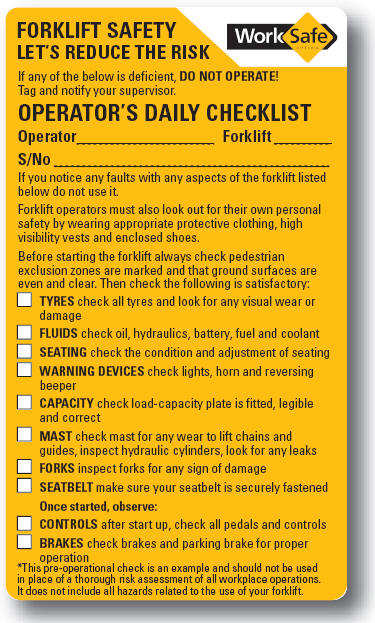 |
| |
|
Source:
Product
| Specs | Operating |
Safety
Version original
Anglais:
howworkliftworks_an Version française
commentfonctionnelecontrepoids_fr
Versions :
trucks_stability_an
stabilité des chariots
élevateur.php |